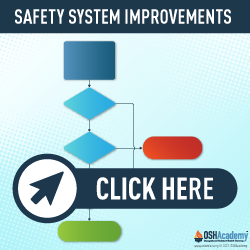Safety System Improvements
An effective ergonomics program operates within a larger safety management system (SMS) that is composed of many interrelated programs.
When hazardous conditions and unsafe behaviors exist, it's usually because the SMS is failing somehow. These failures represent the root causes for accidents and may be categorized as shown below.
- System Design Failures: Inadequate design of the SMS. The development of written safety plans, policies, processes, procedures and practices is very important to make sure appropriate conditions, activities, behaviors, and practices occur.
- System Performance Failures: Failure to carry out the plan as designed. The ability to effectively implement the SMS programs is critical to the success of the system. You can develop a wonderfully designed system, yet if it's not implemented correctly, it won't work.
A missing or inadequate component in any one of these subsystem processes might have a negative impact on ergonomics. Listed below are examples of safety subsystems.
- Safety training
- Safety accountability
- Hazard identification and control
- Employee involvement
- Incident/accident investigation
- Safety communications
- Evaluation and continuous improvement
Missing or inadequate safety system components may represent the root causes for ergonomic injuries. Hazardous conditions and unsafe behaviors represent the outward symptoms that give clues about the underlying safety system weaknesses. Therefore, every effort should be made to improve system components to ensure long term workplace safety.
Listed below are some examples of safety system improvements.
- Include "safety" in a mission statement.
- Improve your safety policy so it clearly establishes responsibility and accountability.
- Change a work process so that checklists are used that include safety checks.
- Revise the purchasing policy to include safety considerations as well as cost.
- Change the safety inspection process to include all supervisors and employees.
- Adopt a continuous improvement process for lowering risk by controlling ergonomic hazards.
Notice that in each example we are describing a missing or inadequate process, policy, procedure, plan, or program that may or may not be directly related to ergonomics.
Knowledge Check Choose the best answer for the question.
5-8. When hazardous conditions and unsafe behaviors exist, it's usually because _____.
You forgot to answer the question!

